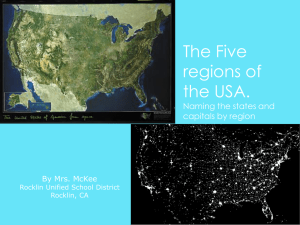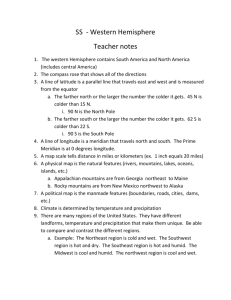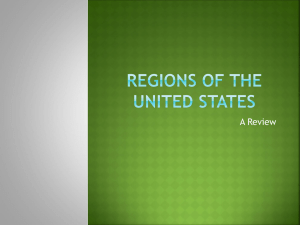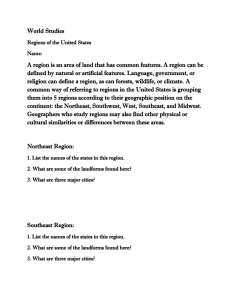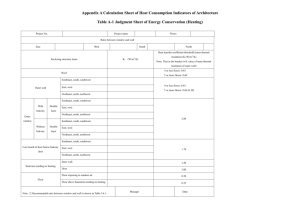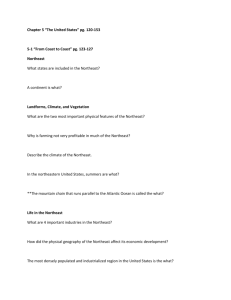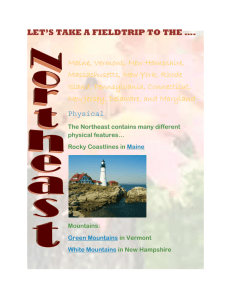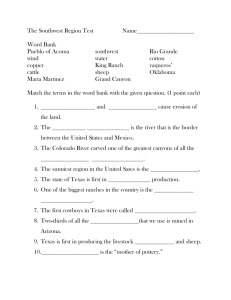US Regions Reading - Staunton City Schools
advertisement
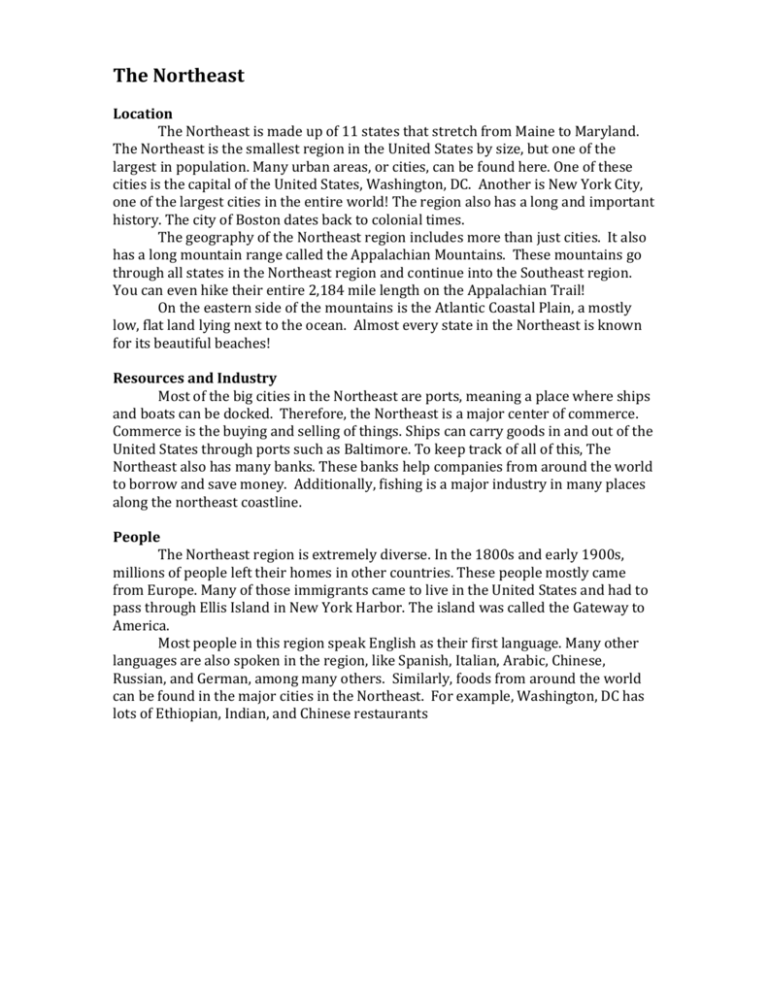
The Northeast Location The Northeast is made up of 11 states that stretch from Maine to Maryland. The Northeast is the smallest region in the United States by size, but one of the largest in population. Many urban areas, or cities, can be found here. One of these cities is the capital of the United States, Washington, DC. Another is New York City, one of the largest cities in the entire world! The region also has a long and important history. The city of Boston dates back to colonial times. The geography of the Northeast region includes more than just cities. It also has a long mountain range called the Appalachian Mountains. These mountains go through all states in the Northeast region and continue into the Southeast region. You can even hike their entire 2,184 mile length on the Appalachian Trail! On the eastern side of the mountains is the Atlantic Coastal Plain, a mostly low, flat land lying next to the ocean. Almost every state in the Northeast is known for its beautiful beaches! Resources and Industry Most of the big cities in the Northeast are ports, meaning a place where ships and boats can be docked. Therefore, the Northeast is a major center of commerce. Commerce is the buying and selling of things. Ships can carry goods in and out of the United States through ports such as Baltimore. To keep track of all of this, The Northeast also has many banks. These banks help companies from around the world to borrow and save money. Additionally, fishing is a major industry in many places along the northeast coastline. People The Northeast region is extremely diverse. In the 1800s and early 1900s, millions of people left their homes in other countries. These people mostly came from Europe. Many of those immigrants came to live in the United States and had to pass through Ellis Island in New York Harbor. The island was called the Gateway to America. Most people in this region speak English as their first language. Many other languages are also spoken in the region, like Spanish, Italian, Arabic, Chinese, Russian, and German, among many others. Similarly, foods from around the world can be found in the major cities in the Northeast. For example, Washington, DC has lots of Ethiopian, Indian, and Chinese restaurants Southwest Location The Southwest is made up of four large states (Texas, Arizona, New Mexico, and Oklahoma). One state, Texas, is bigger than the whole Northwest region. Yet the Southwest has fewer people than any of the other regions. This is because it is mostly a desert climate, such as the Sonoran desert in Arizona. This picture was taken at the famous “Four Corners.” This is corner where four states – Arizona, New Mexico, Utah, and Colorado all meet Resources and Industry The American settlers of the Southwest were usually ranchers, or people who raise animals for food. They were also people who were looking for land to farm or ranch. In Oklahoma, there was a time where people did not have to pay for land. If they were the first to claim it, it was free for them to settle. Today, over 60% of the land in the southwest is used for grazing cattle (cows) or sheep. In Texas, ranchers would walk the cattle to the nearest railroad, where they would be shipped east. Oil has also been important to the Southwest for 100 years. In 1901, oil was discovered in Texas. Soon, thousands of people rushed to the state. They hoped to get rich from the oil. In many areas of Texas, oil pumps still work night and day. People In the Southwest, people mostly speak Spanish or English. The region used to be part of Mexico, so there are many elements of Mexican culture in the region. For example, both Mexican food and clothing are popular in Arizona, Texas, and New Mexico. Many buildings in the Southwest are built in the Pueblo style. This type of architecture comes form Spanish and Native American cultures. The West Location The West is the largest region in the United States that stretches from Colorado to California. It is made up of 11 states, including Alaska and Hawaii. The region also includes Oregon, Montana, Wyoming, and Utah. This region is home to some of America’s most important cities, like Los Angeles, CA and Seattle, WA, but also thousands of miles of natural landscapes and parks, like Yellowstone National Park! North America’s largest mountain chain, the Rockies, can be found in the Western region. They stretch all the way from Canada down to New Mexico. Because of the high altitude and cold temperatures, lots of snow can be found near the peaks of these mountains. However, temperate rain forests can be found around the lower parts of the Rocky Mountains. With lots of precipitation (about 100-200 inches per year!), the temperate rain forest supports a wide variety of life. The Sitka spruce, western red cedar, and Douglas fir are trees native to North America’s temperate rain forest. Some of these trees grow to more than 90 meters (300 feet) tall and 3 meters (10 feet) in diameter. Black bears, Roosevelt elk, and marmots are indigenous animal species. Resources and Industry In addition to mountains and forests, the northern part of the Western region of North America also has the richest deposits of oil and natural gas on the continent. Most of these deposits are located offshore, in the Arctic and Pacific Oceans. For example, underneath Alaska is reported to be enough oil to fill over 10 million barrels! Additionally, water is a major resource for the West. When the snow melts at the top of the mountains, gravity forces it rapidly down rivers and streams on the sides of the mountains. There are many dams that use the strong currents of the water for energy, and drinking for humans, animals, and agriculture. The Hoover Dam, built in the 1930’s, sits on the Colorado River between the states of Nevada and Arizona. People American settlers originally came to the West for economic opportunity. They came for land, to work on the railroads, and to look for gold. In 1849 gold was discovered in California before it was even a state. Within a few short months thousands of people adventured out to California and by 1850 it became the 31st state of the U.S. Before the settlers came, there were many Native Americans already living there. Many conflicts occurred and Native American’s were forced off their land. There are many different languages spoken in the West. English is a major first language for many living there, but many also speak Spanish. Japanese and Chinese are also common languages on the West Coast. Midwest Region Location The Midwest is a region of the United States of America made up of twelve states. They include Ohio, Michigan, Illinois, Wisconsin, Nebraska, South Dakota, and North Dakota. Much of the Midwest is flat and is called the Great Plains. This area claims some of the finest farming land in the world and is known for its corn and cattle. Many buffalo live on the Great Plains as well! The Midwest is also home to the longest river in the U.S., the 2,320-mile long Mississippi River! It starts up north in Minnesota and runs all the way south to the Gulf of Mexico! Throughout history, the Mississippi River has played an important role for shipping, transportation, and communication between the different parts of the U.S. Lastly, the five Great Lakes surround Michigan and form a natural border between the U.S. and Canada. These lakes combined form 21% of the world’s surface fresh water. The Great Lakes Huron Ontario Michigan Erie Superior Resources and Industry Farming and agriculture is a major industry in the Midwest. The Great Plains have some of the finest soil for growing corn and raising cattle (cows). Additionally, some cities in the Midwest are known for their manufacturing of goods in factories. For example, many cars are made in Detroit, Michigan, which has earned the nickname of “Motor City.” People Illinois’ largest city, Chicago, is home to people from all over the world and has Italian neighborhoods, Polish neighborhoods, and a Chinatown, too! This diverse culture makes Chicago a special place to live, work, and play! Long ago, the Native Americans hunted the buffalo to use its meat for food and its skin to make clothes. They also used the buffalo skin to make homes called tepees. Then in the 1800s pioneers, or settlers, moved to the Great Plains from the East and built stronger houses made of sod [a thick top layer of packed soil]. Today, most people of the Midwest own farms and grow wheat, corn, and produce dairy items like milk, butter, and cheese from cows. Southeast Region Location The Southeast is a region of the United States of America made up of twelve states. They include Virginia, Kentucky, Tennessee, North Carolina, Florida, Alabama, and Mississippi. Some states are near the Atlantic Ocean, some border the Gulf of Mexico, and a few are farther inland. The Southeast has something for everyone. Geographically it has both cities and farmland, beaches and mountains, and forests and wetlands. Wetland areas are a biome of the eastern region and consist of areas of land whose soil is saturated with permanent moisture. The Florida Everglades is the largest wetland system in the United States, covering more than 4,300 square miles of southern Florida. The Everglades is a biologically diverse region. Alligators nest in the sawgrass plants, while birds such as egrets, herons, spoonbills, and ibises make their breeding grounds in other wetland tree species, such as cypress and mangrove. Resources and Industry Crops such as rice, cotton, and tobacco grown on large plantations have historically been a big part of the economy of the Southeast. In the 1700’s and early1800’s slave labor was used to grow and harvest the most important resource – cotton. In the 1700’s when coal, a valuable black rock that can be burned for energy, was discovered in the Appalachian mountains. Many people moved to the area and coal mining became the most common job in the region. Many mountain communities in West Virginia, North Carolina, and Kentucky still today rely almost entirely on the coal industry for jobs. Of course, don’t forget those delicious oranges that come from Florida! People The Southeast is home to a very unique blend of cultures. Many years ago, French-speaking families came down from Canada and settled in Louisiana. Known as the Cajuns, this culture is famous for their spicy foods and music, mostly played using fiddles, or violins. In addition, Appalachians lived in small valleys around the Appalachian Mountains and became used to living off the land. They are known for their quilts [blankets] and other fine crafts made from hand. Appalachians enjoy singing and playing bluegrass music on banjos and telling folktales. Lastly, parts of Florida make the Southeast region extremely diverse. Miami, a large city with skyscrapers, is home to people from other countries - most speak Spanish. Many people immigrate here from the Caribbean and Central America.
